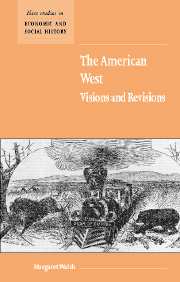Book contents
- Frontmatter
- Contents
- List of maps
- List of tables
- Acknowledgements
- 1 The frontier and the west: realities, myths and the historians
- 2 Land and landscapes: occupation and ownership
- 3 Peoples and migrations
- 4 Making a living: early settlements and farming
- 5 Making a living: non-farming occupations
- 6 Western communities
- Epilogue
- References
- Index
- More Titles in the New Studies in Economic and Social History Series
4 - Making a living: early settlements and farming
Published online by Cambridge University Press: 05 June 2012
- Frontmatter
- Contents
- List of maps
- List of tables
- Acknowledgements
- 1 The frontier and the west: realities, myths and the historians
- 2 Land and landscapes: occupation and ownership
- 3 Peoples and migrations
- 4 Making a living: early settlements and farming
- 5 Making a living: non-farming occupations
- 6 Western communities
- Epilogue
- References
- Index
- More Titles in the New Studies in Economic and Social History Series
Summary
Most migrants to the American west hoped to make their living farming the land. Up to the early twentieth century most western residents were farmers and the rural economy was focused on agricultural productivity. Farmers were, however, more prominent in the Great Lakes, Plains and South Central regions of the west than in the Mountain and Pacific regions of the west and even in the major farming areas some westerners made their living by other means. Some Euro-American pioneers and immigrants moved west early to exploit resources other than the land. They trapped small animals and hunted large creatures. Miners also migrated west. Some hoped to make a fortune digging for gold or silver; others became day labourers working in mines producing both precious and industrial minerals. Yet other migrants sought their living as lumbermen or loggers in the forests. Whether working the land or utilising the other natural resources, the enterprise of all workers stimulated secondary and tertiary activities. Trade and transport connected to the processing and production of resources and services required by those primary producers stimulated the growth of cities and factories. The west then offered diverse opportunities to many and was the workplace of millions more whose lives were governed by the capitalist ethic.
- Type
- Chapter
- Information
- The American West. Visions and Revisions , pp. 72 - 92Publisher: Cambridge University PressPrint publication year: 2004



